

Noyhauser
-
Posts
1581 -
Joined
-
Last visited
Content Type
Profiles
Forums
Events
Gallery
Posts posted by Noyhauser
-
-
Hey Renegade
I've got a couple of points to help you out.
- Large Cruiser: this is a long running debate about the Alaska Class, and personally I feel they are battlecruisers. Going back to the 1907, battlecruisers were intended to fight against cruisers and run away from Battleships. That meant an armor that was only good vs cruiser armaments and speed to get away from everything else. That's basically what the Alaska class is. It was designed to combat high speed commerce raiding by Japanese heavy cruisers (which the IJN actually resisted doing). That's why there were over six originally projected to be built: you needed a lot to defend against such a transient strategy. Its just simpler to add Alaska to the battlecruisers' line and describe it as a battle/territory.
- There really isn't a consistent naming convention for IJN carriers: Hiyo Taiyo, Jun'yo are birds; Shoho, Taiho are Phoenixes; Kasuragi, Amagi and Kasagi are mountains.
- Destroyers: One of the key functions of the destroyers was screening for a fleet. Certainly that meant attacking other screeners, ect. but it also meant smoke screens, which could hide large battle line movements from an enemy fleet.
- Also, I think its really important to give a sense of why Japanese and American designs were so different. The Japanese, under the Washington Treaty Limitations knew they could not win in the numbers' game vs the United States. So they built extremely well armed vessels to counter their numerical inferiority. They basically developed an intricate understanding of the combat power the U.S. Navy could bring to bear in the Pacific, then developed a strategy to defeat it in a large scale naval battle ala Jutland. For example the Yamato's size was what it was because the IJN wanted to build a warship that the US Navy could not develop a counter which could fit through the Panama Canal. This would presumably prevent the U.S. from effectively concentrating their combat power before that decisive battle. Torpedoes were a critical part of this strategy. They had some significant successes with them during the Russo-Japanese War, so they invested in the technology which resulted in the famed Long Lance Torpedo, as well as ships like the Shimikaze. Unfortunately, many IJN ships were too heavily armed which made for poor seakeeping. See this article on the 4th Fleet Incident.
- You mentioned that Pearl Harbor was the most influential aircraft bombing ships battle. If you ignore the strategic effects it had on bringing the U.S. into the war, then I'd argue that Taranto was more influential. It influenced Japanese navy thinking of the possible effects of a surprise attack. It also disabled 1/2 of the Italian fleet at a crucial time during the war: it basically prevented them from destroying the base in Malta and other operations in the Mediterranean. Japanese basically destroyed a bunch of battleships that were not altogether useful in the coming war, and failed to destroy the logistical base that the Americans would use to mount their offensive.
- I think you've confused the sinking of the Shinano, with the Taiho. The Shinano capsized due to progressive flooding after being torpedoed. Taiho sank due to the fuel leak you mentioned. Both were considered Japanese supercarriers.
- Your list of major battles should include the Battle of the Java Sea. It was a major battle that showed the inherent superiority of Japanese seamanship in surface warfare. It was also a tactical and strategic disaster for the Allies, particularly the Dutch, which culminates in the total takeover of the Dutch East Indies.
- The Kido Butai was a force to be reckoned with for seven months between December 7th 1941 and June 4th 1942. They were everywhere in the Pacific. This is the highlights of the Akagi's movements during that time.
- Rabaul 19th January 1942
- Port Darwin 19th February 1942
- Invasion of Java 5th March 1942
- Indian Ocean Raids 26th March 1942 (destroyed a carrier, cruiser and several other major vessels in support of the invasion of Burma.)
- Defence of Japan (Doolittle Raid Pursuit) 18th April 1942
- I've got a couple of more points about the economic dimensions of the war: where the Japanese got their oil, and sea lanes of control, which I think would be of interest to you. Unfortunately I don't have time to finish a response tonight.
hopefully you find this helpful.
-
Each bottle has a little brush attached to the underside of the cap. I just used that.
-
Thanks, usually i prime them but since it's just a small figurine i don't want to buy a can of primer just for it, didn't think of spraying a clear top coat until i realize the problem. plus this is the 1st time i paint on rubber like figures.
Now you call it rubber, is it actually soft plastic? Because its common for small scale figurines to be soft plastic rather than hard styrene, and there is a whole set of techniques available for painting that.
-
Thanks 505, I actually was surprised how well it turned out. I usually build US Navy fighters a bit more weathered and I was worried this might look too toy-like. Didn't come out so bad, but the landing gear could use a bit more weathering. I've built every major aircraft VF/A-2 has operated: the F-14A, D and now F/A-18F. I'm going to line them up in a few days and take a photo.
-
FTFY.
This is an example of a bad fan edit and why one should not mess with Macross 7.
-
it seems like you need a fourth magazine to get the weapons/missle ala Hasegawa
Its not really worth it. The Fine Molds kit is designed with its panels open, radar exposed and wings swept for parking; Its a major no no to have weapons hanging off the side in that state. I also have about 25 Phoenixes in the box due to building a couple Fujimi kits and an extra hasegawa weapon set. The BOL rail and LANTIRN pod is probably the only thing that you would plausibly see.
So if you want to realistically model the aircraft, then you don't really need the set (actually you shouldn't get the set). If you want to make it "look cool" then I guess you can go with the missiles, but it would look silly to anybody in the know.
-
Hey y'all... just finished this up (almost... some details need to be fixed). Its a Hasegawa F/A-18F kit, in the VFA-2 scheme, using Modern-Hobbies USN/USAF pilots.
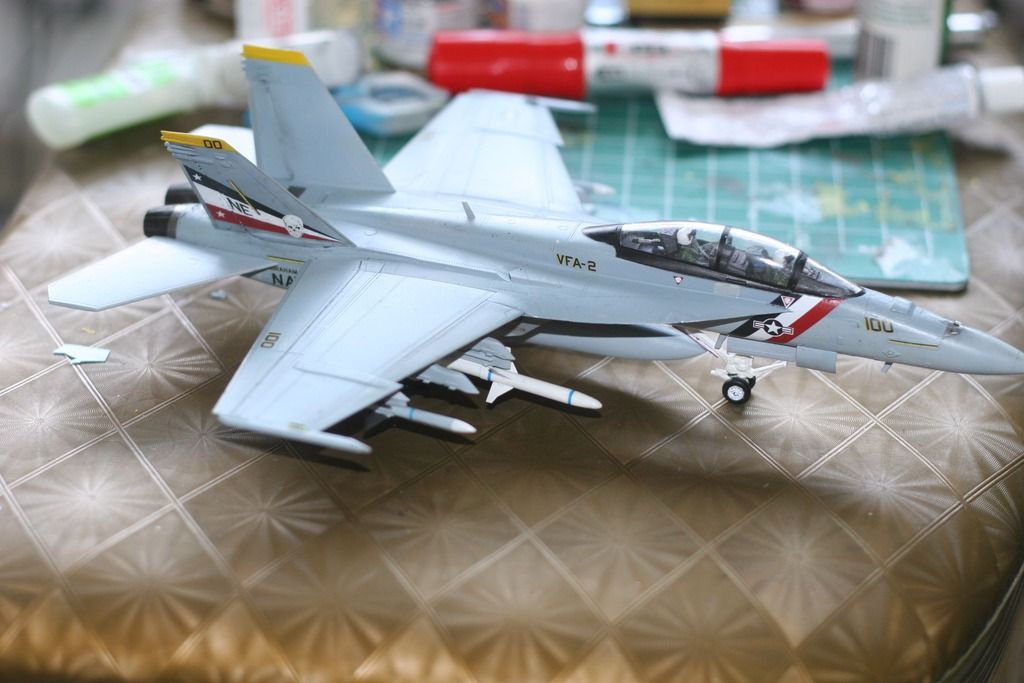
 Next one will be a 1/72 Hasegawa VF-1 gerwalk. I'm not sure what scheme I'm going to build however... either the OOB hikaru, or DYRL Hikaru, or Cannon Fodder. Any thoughts?
Next one will be a 1/72 Hasegawa VF-1 gerwalk. I'm not sure what scheme I'm going to build however... either the OOB hikaru, or DYRL Hikaru, or Cannon Fodder. Any thoughts? -
Like this?
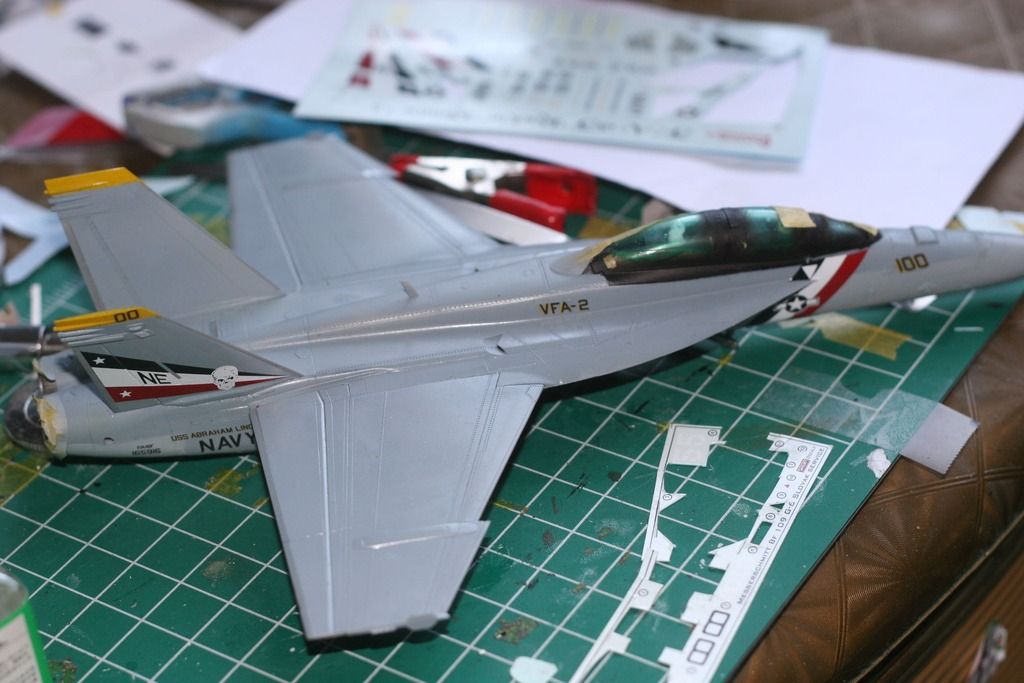
It works pretty well. Its best used for large areas, particularly where the frame might have a curve to it, as the thin strips of tape can be made to match the contours. Just note that if you're using the Gunze stuff, that it will react with a future layer if it is not completely cured. That's never happened to me personally, but I've heard others complain about reactions happening.
-
Sure, except that future also protects the canopy from damage, which is pretty helpful for vacuform which cannot be glued.
I use a different method I pulled out of Model Graphix a couple of years ago. Basically you cut out small squares which you progressively build up a mask for a square. This is a SB2U Vindicator I built a few years ago.
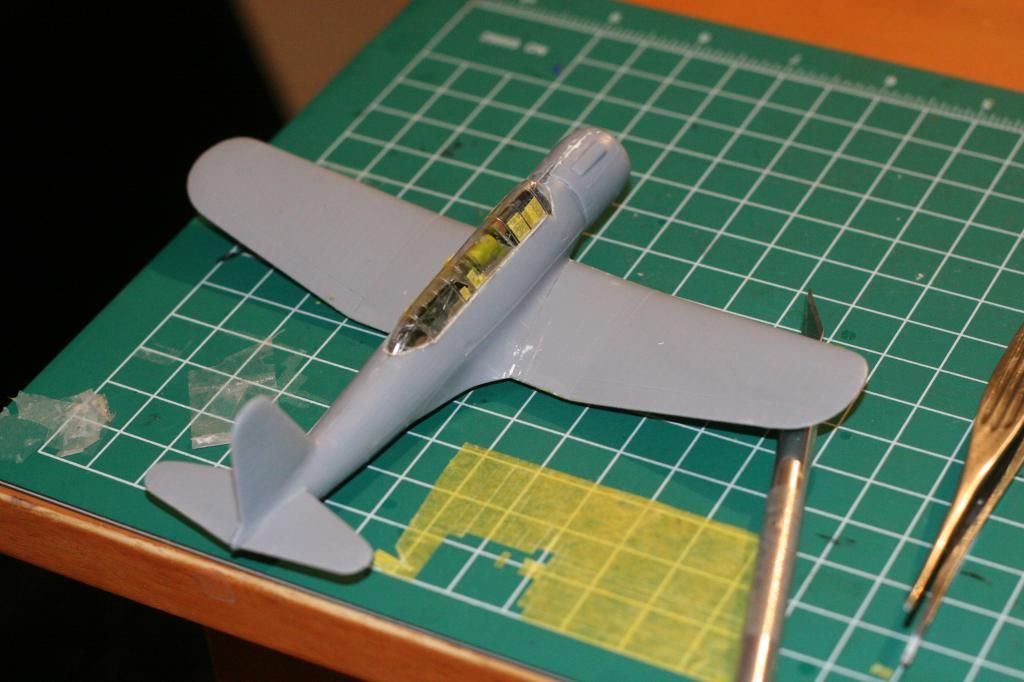
Basically you cut out small squares which you then apply to the area. You slowly do that until you make a complete mask. With a bit of practice you can also do it for curved surfaces, which is really useful.
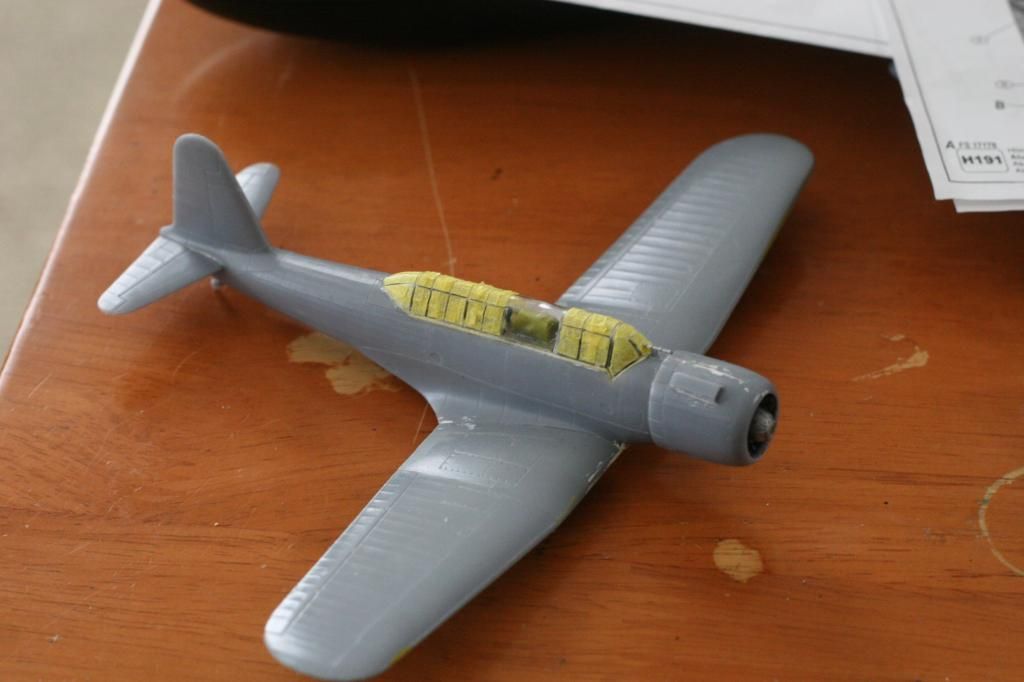
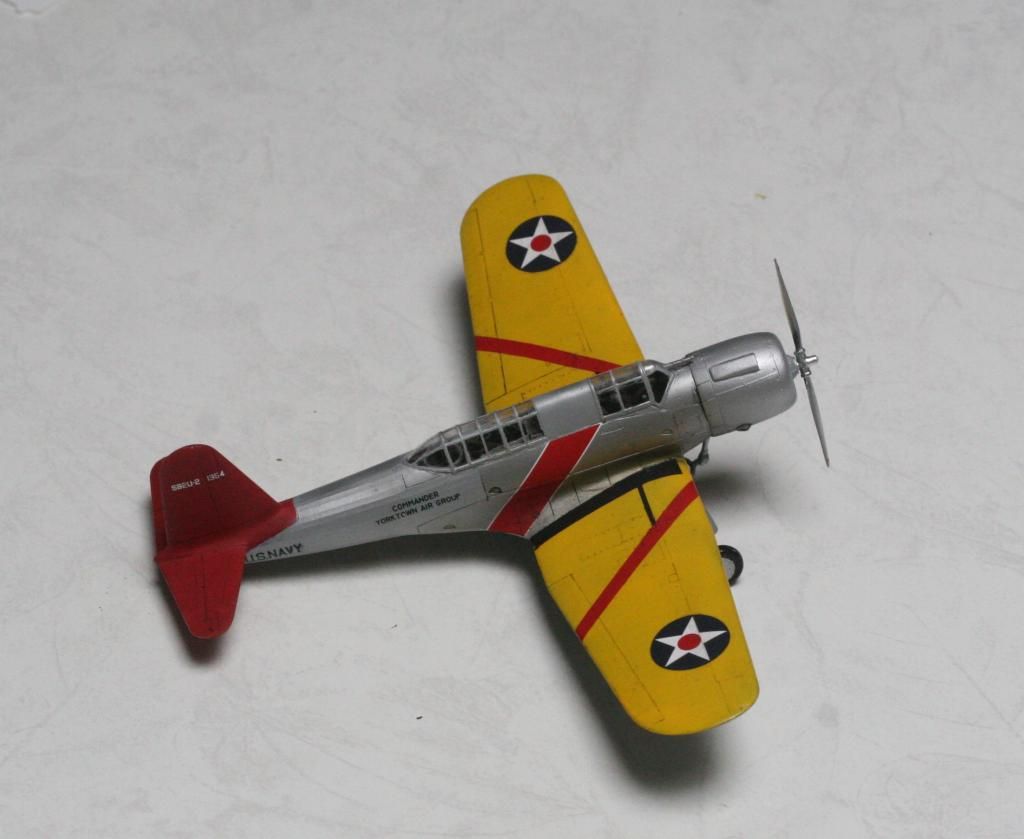
Now my error with this kit was that applied future as a sealant over top of the aluminum finish... which was a really bad idea because I got bleed through which damaged the crisp edges of the canopy frame mask. Unfortunate, which is why I don't apply it anymore on canopies, regardless of the situation.
-
Great work
How do you approach canopies?
Ah, those aren't my better works in this area (most of those kits, except the 1st one are over 5 years old). However vacuform canopies are always a bear to do. I tend to do do an initial scoreline, then follow up with the exactoknife, deepening the score until it I break through. Then I sand the bottom flat (if required) by a file or a fastened sandpaper piece.
Then is the tedious job of mounting; this takes a lot of time to fit it, cut down excess areas, and test it again. Often its not going to be 100% as you'll affect the proper shape too much.
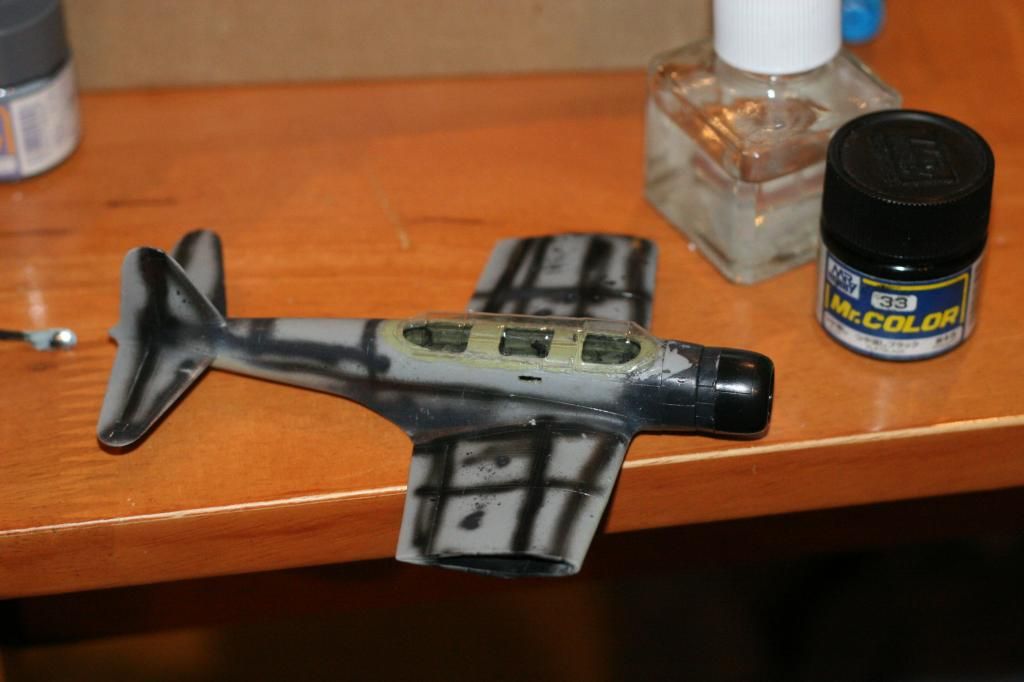
Next I dip it in future: its critical for three reasons. #1 it gives the canopy a glossy look that is more realistic. #2 its a somewhat weak primer, which helps the paint adhere to the smooth surface. #3: it protects the plastic from damage, particularly if you decide to use CA to glue parts of it.
After this step is masking... which can be the longest part of this effort... like with WWII japanese aircraft.
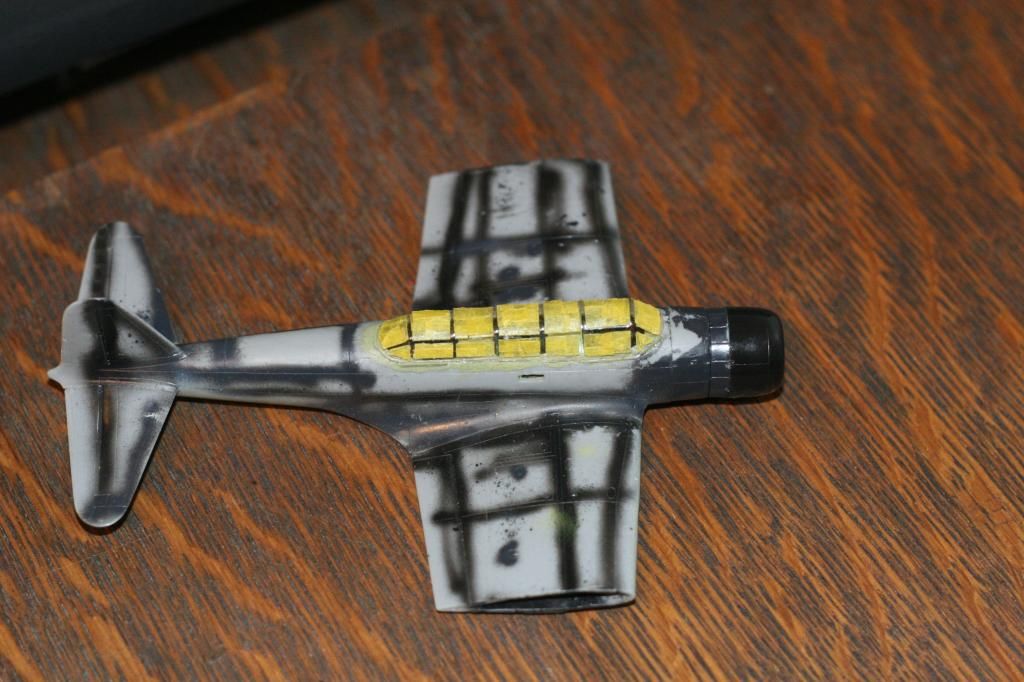
Afterwards I affix the canopy to the aircraft, usually using a white glue type item (gatorglue) that fills in any gaps, with a very little bit of CA on some of the better bonded areas. That's often unnecessary though, as gate glue does a good job of keeping in place. Afterwards, I usually paint the interior frame colour first... like with black for this B5N, as the interior is black.
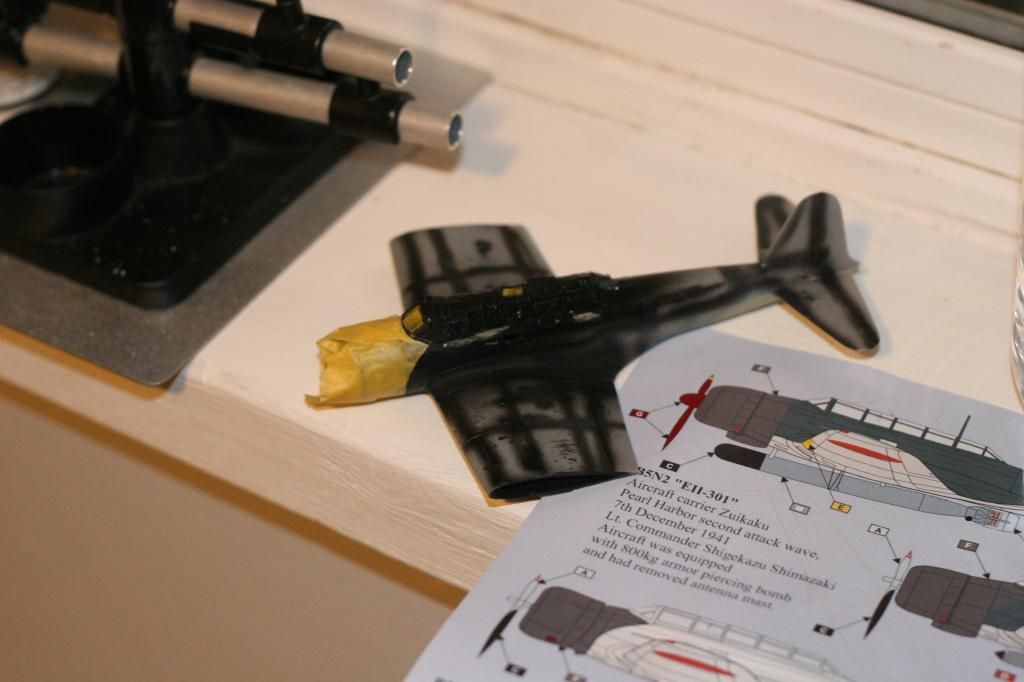
Finally I hit it with the main colour, but I do not do a gloss coat over the canopy area: future tends to run and create some bad isutations. Rather I only put the final top coat (like a satin or flat) and call it a day unless there is weathering to be done. The B5Ns During Pearl Harbour were relatively new, so I didn't do that much. Excuse the dustiness, I think there is some stuff on the camera lens that's making it look a lot less clean than it actually is.
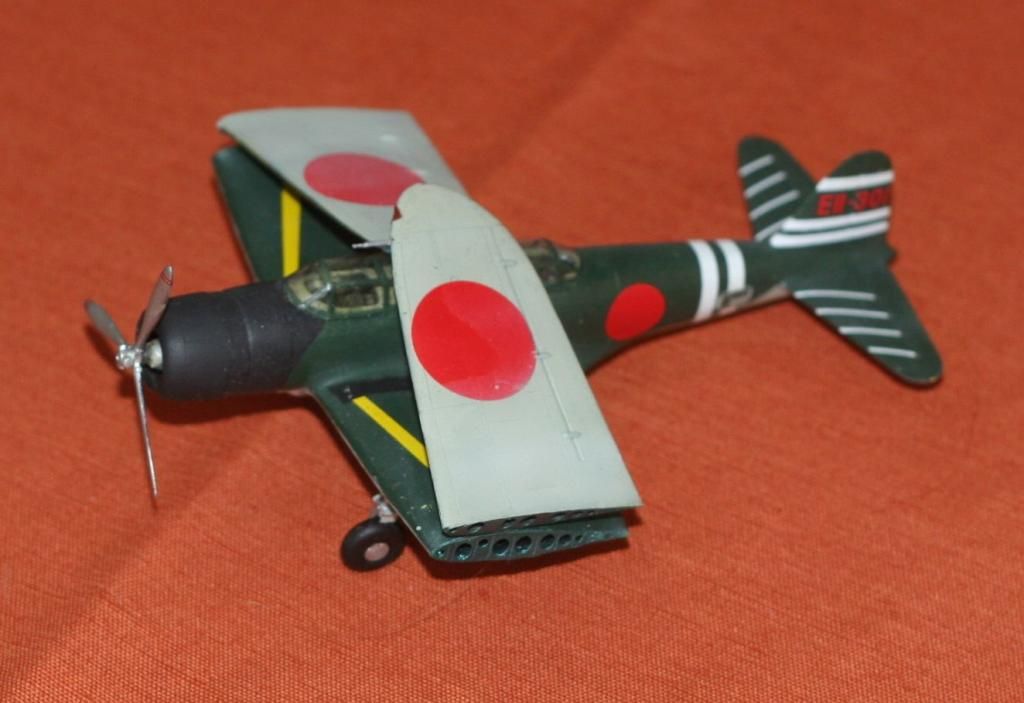
-
Thanks for the replies guys!
@galaxy_stranger
I have no problem with paint and grease on my model as well but that is because they are plastic models. From what I heard/read, resin has some serious Mold Release that needs to be removed. Of coure, a lacquer based primer will help since the hotness can pierce through the grease
@noyhauser
thanks as well, good to know that Tamiya primer works. I actually got a spare Tamiya PINK lying around, this makes it easier for me since I dont need to buy extra tools
Thanks for the replies guys!
@galaxy_stranger
I have no problem with paint and grease on my model as well but that is because they are plastic models. From what I heard/read, resin has some serious Mold Release that needs to be removed. Of coure, a lacquer based primer will help since the hotness can pierce through the grease
@noyhauser
thanks as well, good to know that Tamiya primer works. I actually got a spare Tamiya PINK lying around, this makes it easier for me since I dont need to buy extra tools
I've probably built 10+ resin kits over the years, mostly WWII or Cold War fighters, with a couple of Macross kits thrown in. Very few have any mold release problems. Actually only one had any problems. Then again, most of mine were Czech, not Japanese, and they tend to have higher production runs I've probably had to clean less than a 1/3rd of them... though its a good general rule to. Or not. Its really never bit me in the ass before.
Here's a couple I've built over the years.
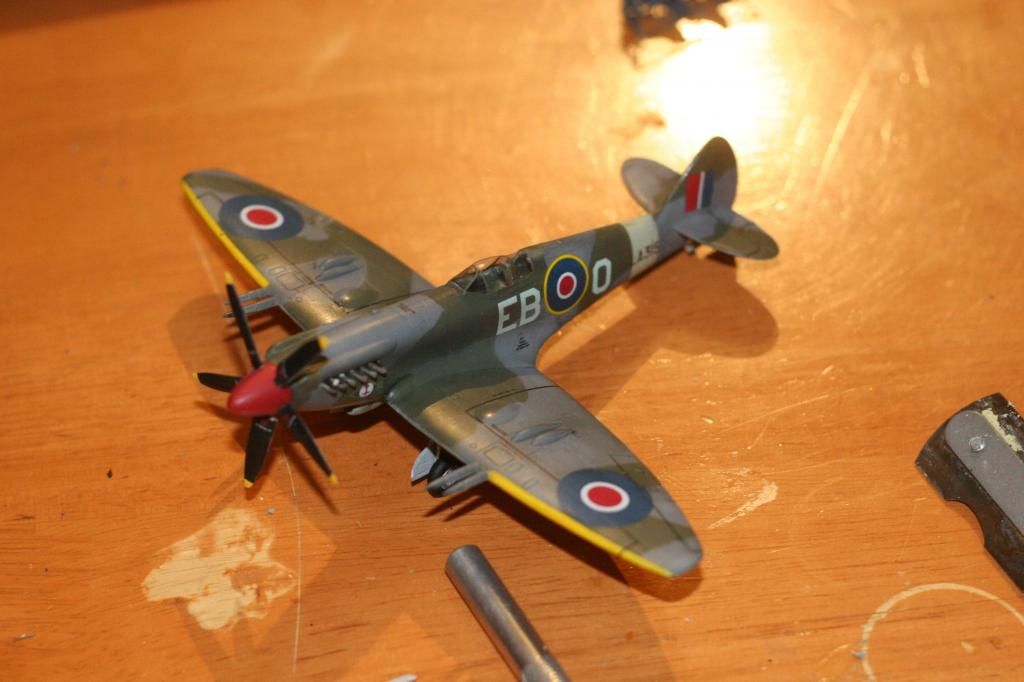
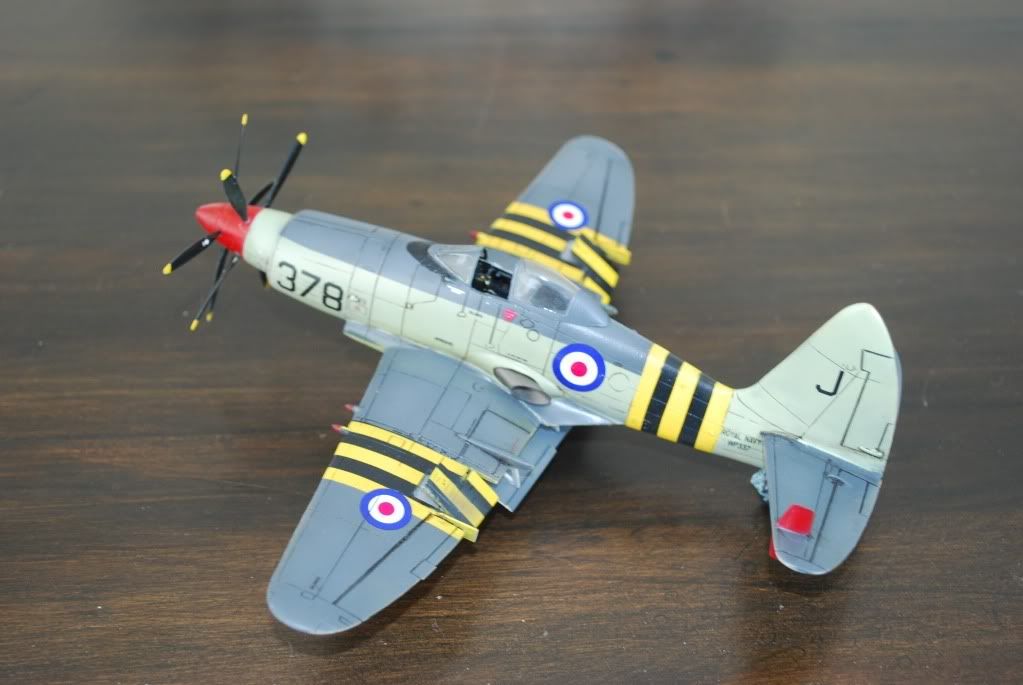
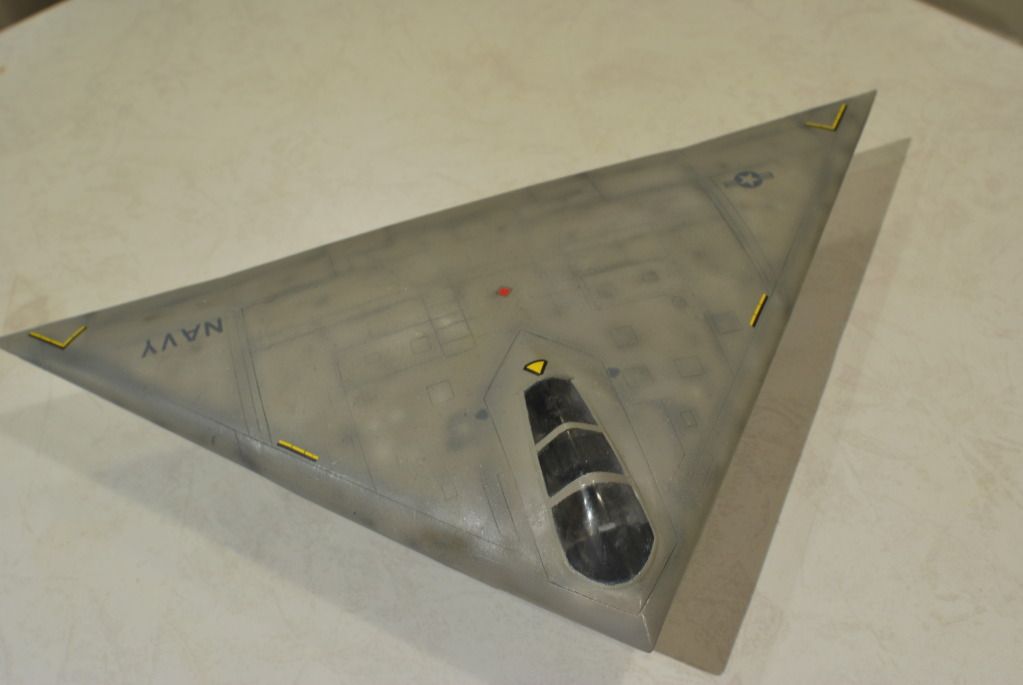
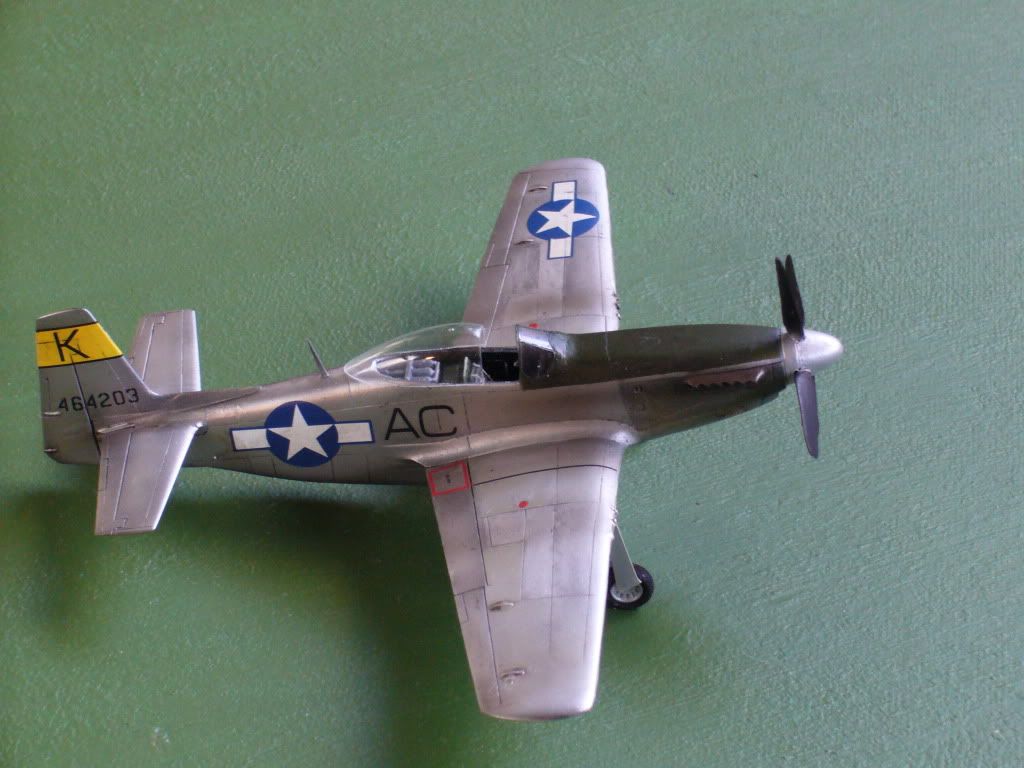
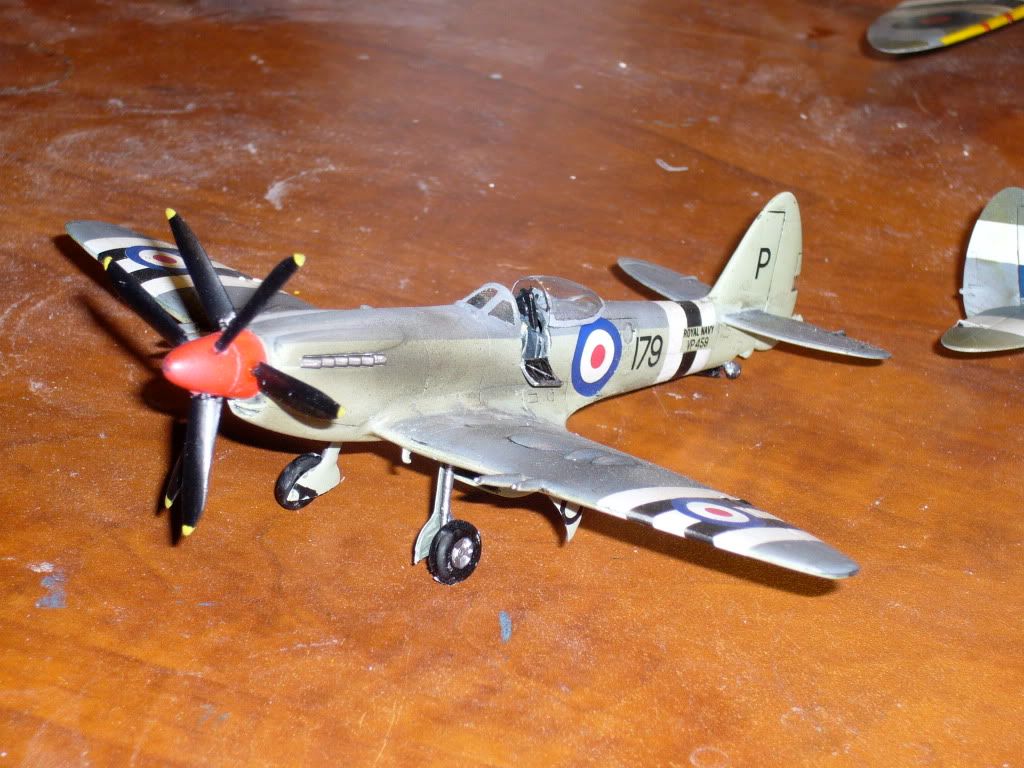
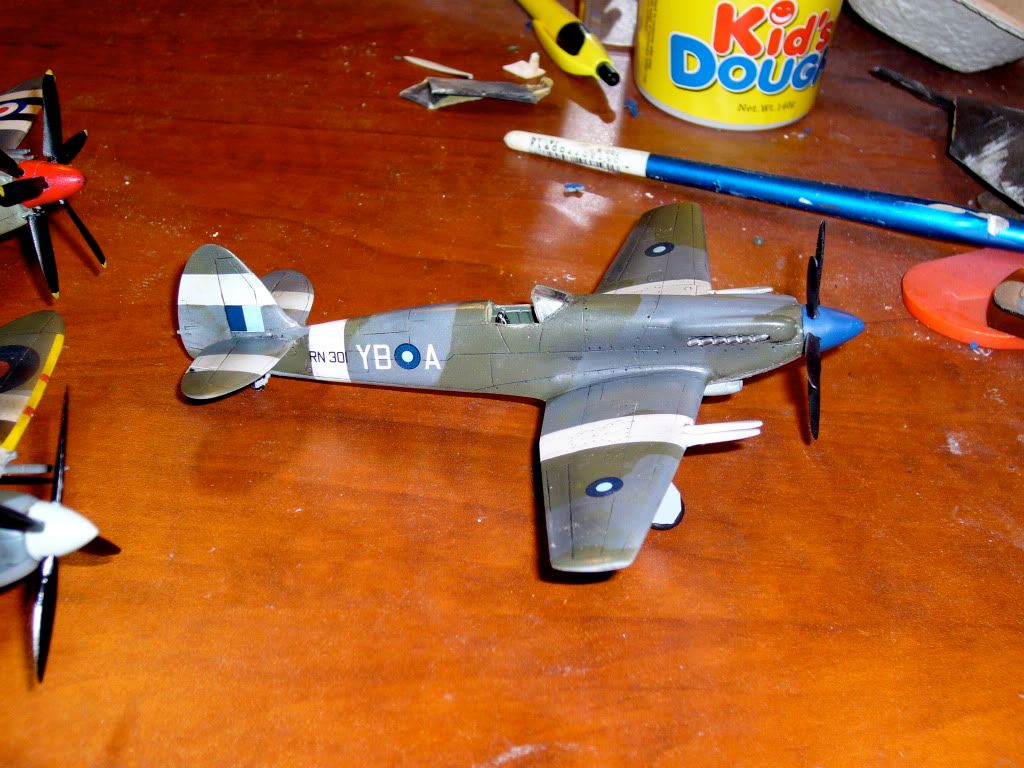
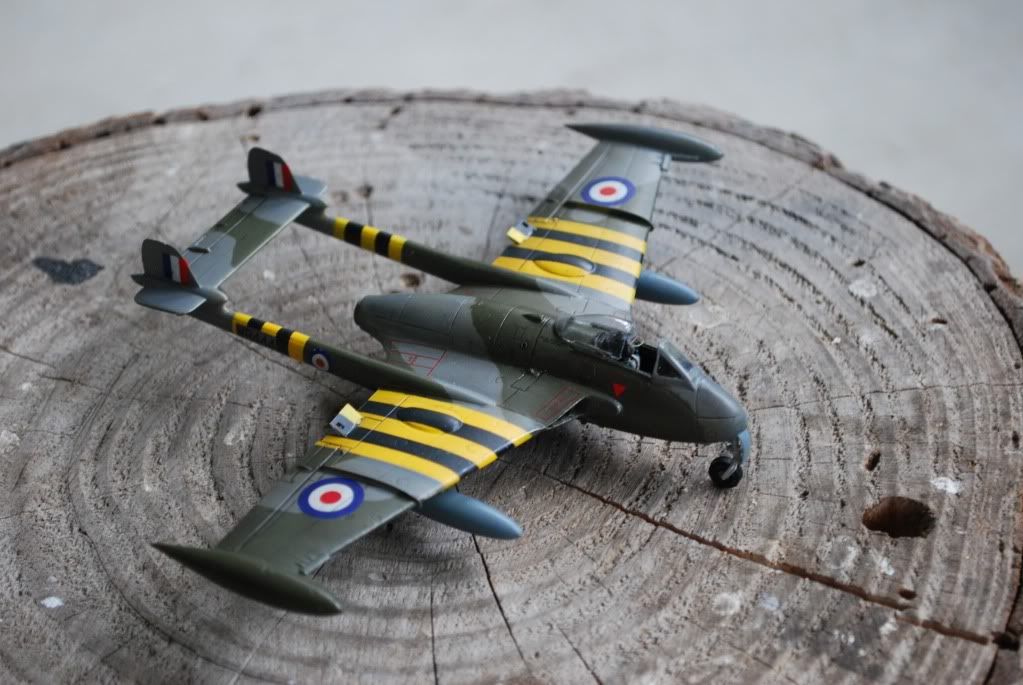
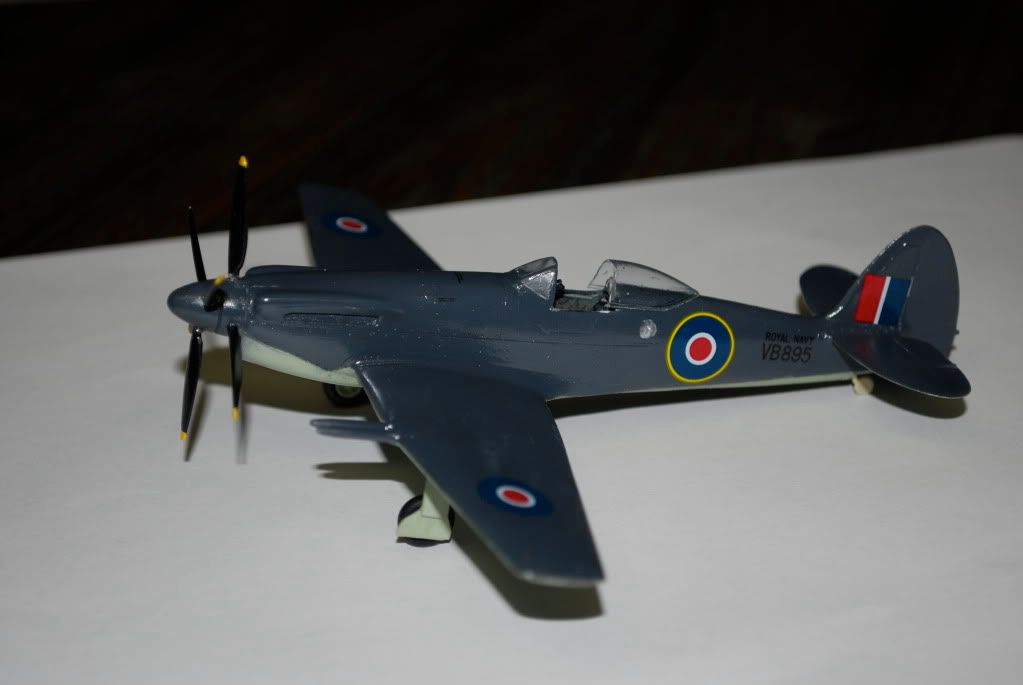
-
bought this at mandarake
http://ekizo.mandarake.co.jp/shop/en/item_s-2035231.html
a 1/144 fighter mode VF-5000g
i think it is a resin model, and this will be my first experiment towards resin parts
1. Will normal lukewarm and liquid soft solution be enough to clean it?
2. Will normal primer work? like Tamiya Surfacer/Primer
3. Do I have to use special type of glue?
4. Anyone can share a completed build to take inspiration from?
1: probably better to use a stiffer brush and some laundry detergent... that gets most of the mold release agent off.
2: yes, absolutely. This is a Venom FB.5 I built probably 8 years ago with tamiya primer on top. Still looks good today.
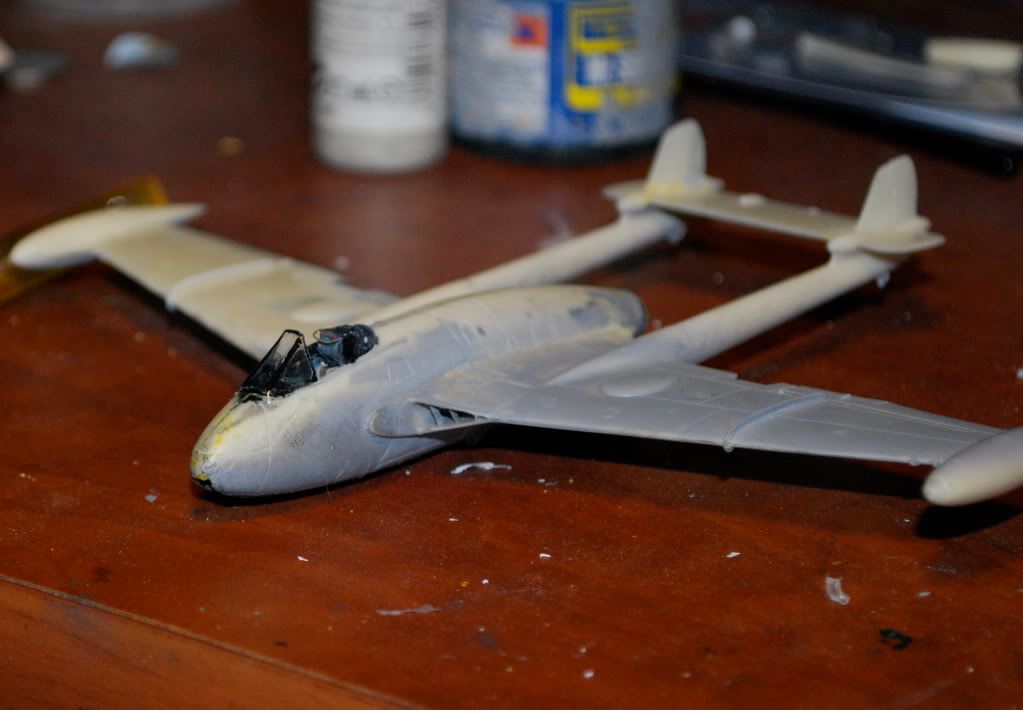
3) I use Cyanoacrylate (crazy glue) for everything. I have 10 year old kits that look fine today (like the one above).
4) Jefumon may be building the same kit as we speak in the workbench thread. However I never seen the VF-5000 built. If you want some inspiration, search the forums for VF-4 in 1/72, and you'll come across a lot of very high quality resin works.
Hope that helps.
-
Supposedly really cheap to fly though, Textron quotes $3000 per flight hour, less than $20 million each. 3,000 lb internal bay, up to 4,000 lb on six wing hardpoints.
Dunno, the USAF has historically shown no interest in CAS, I think they should change the Pace-Finletter agreement from restricting Army fixed-wing aircraft based on weight, to a restriction based on top speed, say, 450mph. This way the Army can have all the A-10s and equivalents they want, and the AF gets rid of a mission requirement they never had any interest in.
Yes, because 200,000 sorties of CAS and 15,000 strikes over the last 15 years proves, beyond a reasonable doubt, that the USAF has no interest at all in this mission.

-
Its a privately funded effort by textron. Didn't look look like it had much in the way of prospects (the lightweight market is highly saturated right now with no less than six different aircraft with similar capabilities) but it is possible that it might be bought by the USAF as a stopgap for a very lightweight CAS aircraft in light of the A-10 retirement. Its really a longshot though.
-
^
Talk about alien prejudice: nobody ever listens to Worf.
-
Whoah... haven't seen them in years. they are 1/144 right? I wanted a few of them back in the day to go with my Tect/bandai kits.
-
Quite sad... even at 83 he seemed very active and with it, so its very sad to see him go.
-
There have been a few cases where even though a new system has worked, other reasons have prevented it seeing widespread use. When they were testing "decoupled manoeuvres" (for example, travelling in one direction but having the aircrafts nose point off the actual line of travel) back in the late 90s, it was thought that although they had some potential combat value, the skill required to process and actually make the move might be beyond the average squadron pilot (as opposed to the test pilots engaged in the experiments). Additionally, improvements in missile technology also meant that close-in dogfights where such moves would be most advantageous may have been considered as less likely to occur.
Actually, "decoupled manuevers" are valuable... in reality they are a variation of instantaneous turn performance, which is among the most valuable type of aircraft performance in the age of high off boresight all aspect missiles. Note that the Hornet has very good instatenous turn, and the F-35 emphasizes that type of maneuverability.
Yeah I'm sure in the F-35s long service career it will never once see flak or lose an engine over enemy territory. Say what you will bout the a-10 being antiquated but at least it could get home on one engine if things got rough.
Why would it need to fly vs flak? How effective was Iraqi Flak vs F-117s during the Gulf War? Negligible. How effective was it vs A-10s? Basically it, along with MANPADs contributed to the aircraft suffering the highest rates of attrition among all coalition aircraft, and having it pulled from the front line. And why? because it flew the vast majority of its missions under 10,000 Feet. F-16s and F-15Es saw 1/4th the losses per strike, mostly because it operated at higher altitude and employed maverick and other precision munitions.
You call the F-35 fragile... In reality, in the age of very high probability to hit missiles, getting hit means you're dead. And as such, the A-10 was probably the most vulnerable aircraft on the battlefield. The best course of action is not to get hit at all, and the A-10 wasn't going to get anymore survivable, no matter how much money is thrown at it. Only with the Precision Engagement upgrade to the A-10C was it able to effectively operate like all the other aircraft the USAF employs.
Not saying I agree, but I think the key idea is that the concept of air support has changed. Previously, it was necessary to have an aircraft that could get "down and dirty" with the troops, because identifying friendly/enemy forces required getting in close, and delivering munitions with the necessary accuracy when troops were closely engaged meant getting right on top of the target. Now that lower-cost, smaller precision munitions are in widespread use, and ground troops may even have the ability to designate targets for their air support, it's not necessary for an aircraft to get down in the mud. It's just a delivery system for smart munitions, so tacticians can focus on the get-in, get-out approach to survivability without (theoretically) undermining an aircraft's ability to perform effective ground support. If that's the paradigm, then, yes, an F-35 - with stealth, speed, and altitude - is far more survivable than an A-10 that loiters over the battlefield and flies right up the nose of enemy air defenses.
The question I don't feel the F-35 answers is battlefield availability. Loiter time was a major factor in the A-10's design, because the best air support is the air support that's on-hand when you need it. An F-35 isn't going to provide that. I feel as though, if the paradigm I described above is valid, the better model for modern air support is relatively cheap and plentiful stealthy drones that can orbit the battle space with smart munitions ready to go.
Stealthy drones are already starting to become part of the equation. This isn't really an F-35 vs A-10 argument. Really its an emerging concept of operations that concerns a whole whack of systems: low, medium and high altitude drones, eyes on the ground, ground based sensor systems, satellites, manned aircraft, SIGINT, Arty, direct fire, ect, to support the operation. The F-35 is built with that battlefield in mind. The A-10 has been upgraded to roughly current standards, but that goalpost is already moving. So, in a period of deep fiscal austerity, the USAF has chosen to prioritize a weapon system that emphasizes that future.
-
Yup I love that story, I'm sure the F-35 will be able to do the same....oh wait it won't.
No, it has an Automatic Ground Collision Avoidance System, which will save far more people's lives than manual reversion will. Moreover the A-10 will need it. Its slow speed and poor transonic performance makes it extremely vulnerable to modern air defences. Its survivability against double digit SAM systems or even new MANPADs is not high. Basically the aircraft can only operate in a permissive environment.
No, because everyone will point out that the F-15 lost the vast majority of its wing, vs "a chunk of it".

Anyways---IIRC, an F-18 was tested with a "battle damage" program that allowed control to be transferred to other control surfaces. As in, if an aileron was damaged, the tailplanes would have augmented differential to compensate, and try to retain as normal-feeling flying characteristics as possible to the pilot. I think it even allowed for loss of tailplane pitch control, by using symmetrical aileron movement, to alter the center of lift of the wing.
Did anything ever come of this, in common use/frontline fighters? Seems a waste for a successful program not to be implemented.
I think you're referring to the Self-Repairing and Self-Diagnostic Flight Control System (SRFCS)... which was originally tested on NASA's F-15 back in 1990s. I know components of the system are used in the F/A-18E/F (since McD actually was a co-partner with NASA on the program), and have been employed in several occasions. I'm almost certain that the F-35 has it or something like it, given what we know of how some aspects of its FCS operates in various areas (like with AutoGCAS)
And F-14s have landed at full sweep, and flown normally with one wing swept and the other at min sweep, and this was before fly by wire was even an idea.
I just chalk it up to sensible design requirements for a combat fighter craft.
I don't know about any battle damage programming reaching the front lines or not. It seems like it would, but I know for a fact the military is more concerned with bureaucracy when it comes to upgrading aircraft, than with results, a lot of the time.
Oh, that's total BS. All Aircraft see constant upgrades, including new EW systems, radars, Comms, weapon plug-ins ect. The reality is quite a few of these systems need to be flight tested beforehand to ensure proper integration: you can't just load up anything at your whim and expect it to work, or not to create interference. The SRFCS can only be loaded into aircraft with full digital FCS, and effective health management system to identify failures. Really, only aircraft built in the 1990s could potentially potentially carry the system.
-
-
Thank you for all your input. I would love to own a VF-4, however no matter what it is (model, toy and etc.) it is always super expensive.
I will keep everything you mentioned in mind and consideration.
Thanks.
If you want something transformable, go with a toy. Going with this kit could be setting yourself up for big disappointment. I'd suggest that this is basically one of the most challenging plastic/resin kits out there: only detailed vacuform may pose more difficulty. A toy would be cheaper, and you'd get like 90% of its detail. If you just want a VF-4, there are non-transformable resin kits that are much easier and look fantastic too.
-
Hi
I don't have the kit, but I've seen a few of the Studio Half eye over the years. Let me be honest: unless you are a very highly skilled model maker, I would suggest that this might not be the kit for you. I'm decently skilled modeller with 150 kits under my belt... and I wouldn't buy this kit. Couple of reasons why.
#1: kits like these are very fragile. over tightening a screw will crack the resin and you're screwed.
#2: they are technically very complex. You have a lot of small parts that must be perfectly aligned to get the transformation sequence to work. You'll need to correct warpage as well.
#3: the transformation is more of a gimmick. You can definitely transform it, but nothing like a toy. All the work on the finish you put in will quickly be lost after successive transformations.
Really, you should have quite a bit of experience in resin and articulated figure design before tackling this piece. If you're cool with that, then go ahead... I looked through the parts list and I suspect it has all of the joints included.
-
Looking good derex... I can commiserate about hard materials but you did a bang up job.
A little more progress on the Shornet... Painted some of the detail areas like the tail leading
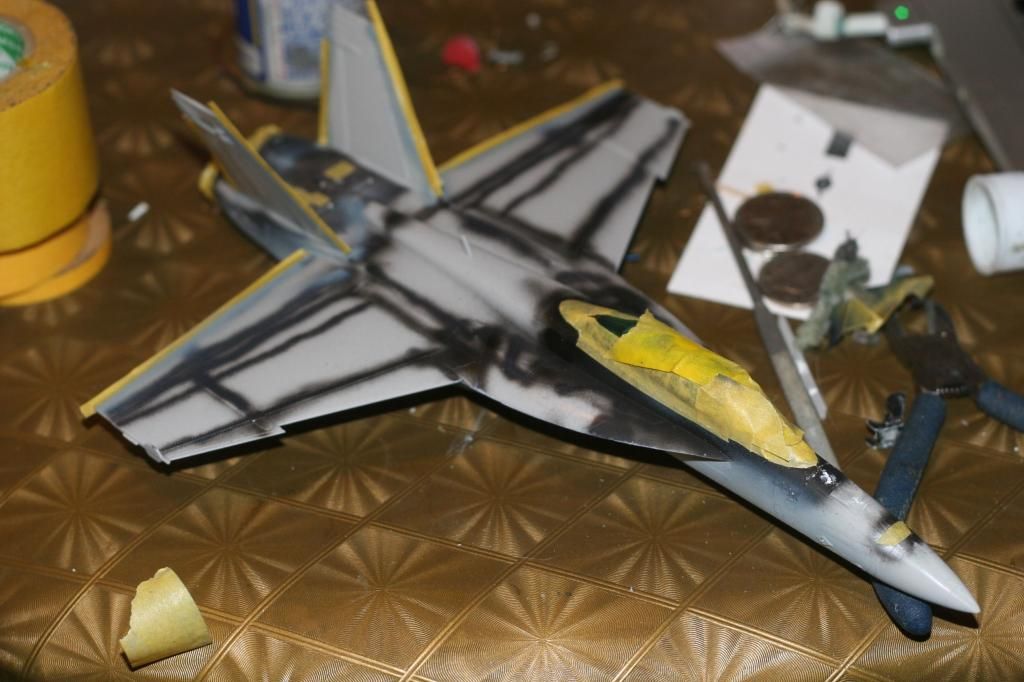
And the top 1/2 of the aircraft.
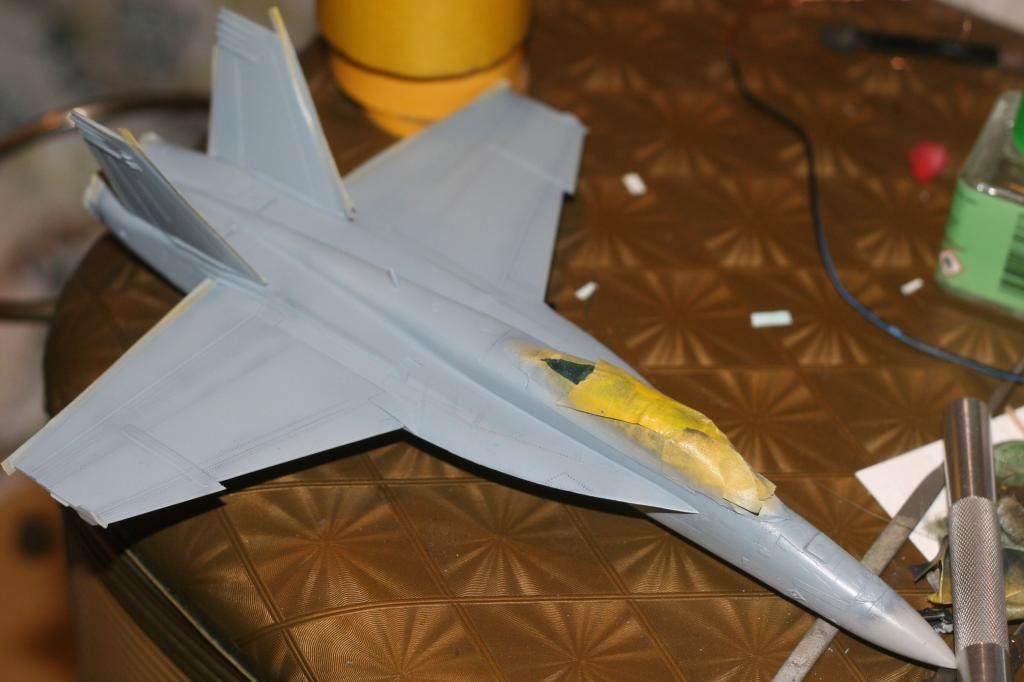
That's all for now...
-
The Air Force, for whatever reason, has always disliked the idea of moving mud. Bombers yes, CA, not so much. It's very believable that many in the AF want to be rid of it.
I think that's been a bit of a misconception, particularly given that the past decade has seen the USAF do little else but CAS. Much of the view of the USAF's past resistance is critiqued in this post:
http://elementsofpower.blogspot.ca/2011/07/debunking-close-air-support-myths-part_24.html
But there's other reasons for that as well. I can't say what they are, but the reasons are valid. The thing is, in my opinion, those reasons are outweighed by the Hog's effectiveness and the fact that nothing in the current inventory can really take its role. The Strike Eagle comes closest, but it really doesn't have the legs or survivability to battle damage.
As for airmen not being able to express themselves freely - that's true, always been true, and don't believe differently.
I really disagree with this statement. The reality is that most tactical fighters can do the CAS role significantly better than the Warthog can. The Warthog has accounted for less than 1 in 5 CAS sorties in Iraq and Afghanistan. Why? Because the way that CAS operates has changed. CAS isn't really about going low and gunning down targets with the Avenger. Rather its mission that employs a variety of systems and platforms, from the JTAC on the ground, UAV sensors in the air, artillery, and aircraft. Within current doctrine, aircraft typically deliver precision guided munitions at medium to high altitudes utilizing advanced targeting pods like Litening or Sniper. The combination of the two make for a far more lethal capability than in previous generation. We now have bombs with a wide variety of effects, from the 250lbs Small diameter bombs, 500lbs cement LJDAM, to 2,000 lbs JDAMs... CAS is conducted with a precision now that was never dreamt of before. The last series of upgrades to the A-10 would basically allow it to operate more like its brethren, the F-16 and F/A-18, not vice versa.
Ironically, many cite Desert Storm as the turning point where the USAF changed its views on the necessity of the A-10 and its low level CAS mission. The reality was quite the opposite: DS made it painfully evident that low level strikes were not survivable by any aircraft, particularly the "armoured" A-10. It suffered disproportionate losses, due to its low level attack profile. Their most effective weapon was not the GAU, but the AGM-65, a weapon almost every other fighter could carry. The A-10 was further handicapped by the fact it did not have a infrared targeting pod like LANTIRN; pilots were forced to use their Mavericks as a ersatz IR sensor due to this limitation.
Why is does the USAF want the A-10 removed? For a number of reasons. It reasonably believes that it can undertake the CAS with other assets, as it has been doing since 2001. Moreover, sequestration has had grievous impacts on its budget and it is trying to scrounge up every penny and resource to support its transition to the F-35. While the A-10's 3~4 billion dollar budget seems small compared to the multibillion dollar JSF, it takes up an important part of the service's resources. A few months ago the JSF PEO Chris Bogdan suggested the F-35A's IOC would be delayed because of Congressional resistance towards retiring the A-10.
That's basically the lay of the land. I think within the Service and its perspective, there isn't much dispute about whether the A-10 can be effectively replaced by other aircraft: it already has. Rather the A-10 replacement is really a political battle that any serviceman or woman will be wading into if they make a statement. The congressional authorities perspectives are not entirely motivated by a reasonable difference on what mix of capabilities are required. Rather, it is motivated in part to keep bases open in their home districts, which further hamstrings the USAF's ability to make rational decisions about its future force structure in a period of growing instability and austerity. AF officials speaking on this topic are basically operating against the best interests of the service.
Anyway, I hope that provides you with the perspective about why the A-10 is being retired and all the atmospherics surrounding it.
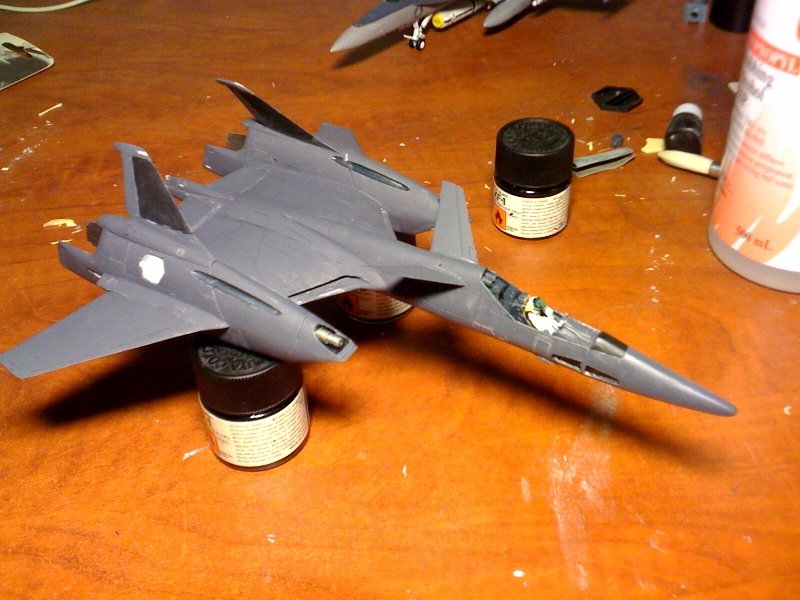
Beginner's Model Building Construction BASICS
in The Workshop!
Posted · Edited by Noyhauser
beat you to it.
As you say, its all about the curing time. Gunze in general cures slowly, nearly as long as some enamels. You;ll see it crack future if the latter is applied too early (within a 24 hours in some cases).